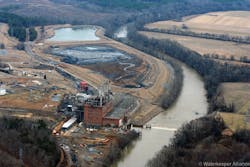By William Steel
Industry, enviro groups clash over EPA revisions to coal combustion residuals rule
In summer 2018, the U.S. Environmental Protection Agency (EPA) finalized a series of revisions to the federal regulations for the storage and disposal of coal combustion residuals (CCR), also known as coal ash, from electric utilities and independent power producers.
With coal the fuel for approximately one-third of electricity generation in the U.S., coal ash is one of the largest industrial waste materials in the U.S., amounting to some 107 million tons in 2016. As such, its safe handling has been high on the agenda of environmental groups for some time.
Coal fuels approximately one-third of electricity generation in the U.S., making coal ash one of the largest industrial waste materials in the U.S., amounting to some 107 million tons in 2016. Photo by Waterkeeper Alliance.
The latest amendments, however, have done little to appease those who have advocated for stronger regulations surrounding storage of coal ash — something typically achieved by means of flushing coal ash away from plants and into ponds or impoundments built up from earthen damns.
The first-of-their-kind federal regulations introduced in 2015, ‘CCR from Electric Utilities,’ established technical requirements for coal ash storage, and thereby safeguards against pollution, under subtitle D of the Resource Conservation and Recovery Act (RCRA), the primary federal law regulating solid waste.
Although subtitle D ascribed coal ash status as non-hazardous waste, EPA lists 21 contaminants within coal ash, including mercury, lead, cadmium, arsenic, and vanadium. Major coal ash spills in Kingston, Tenn. (2008) and Eden, N.C. (2014), along with numerous ongoing legal cases involving coal ash pollution of rivers, lakes and other water bodies, are taken by environmental stakeholders to indicate both the potential harm of coal ash leaching, leaking, or otherwise entering water bodies, and the unsafe nature of coal ash storage by pond or impoundment.
Against this backdrop, the EPA has stated its new amendments will “deliver utilities and states greater flexibility in how CCR is managed, and in turn pave the way to annual savings of between $28 and $31 million in regulatory costs.”
The Amendments
The amendments — described as Part One of Phase One to indicate EPA’s stated intent to deliver further revisions — stem from an industry petition filed with the Trump administration in 2017, and adjust coal ash regulations in three key respects.
Headlining the amendments in relation to operating standards of coal ash storage is introduction of alternate performance standards for states operating approved CCR permit programs under the Water Infrastructure Improvements for the Nation (WIIN) Act, or EPA where EPA is the permitting authority.
The change enables suspension of groundwater monitoring requirements “if there is evidence that there is no potential for migration of hazardous constituents to the uppermost aquifer.”
Also in relation to performance standards, operators would be allowed to demonstrate CCR regulations compliance via technical certifications issued by state officials, rather than through approval provided via professional engineer inspection as before.
Another amendment revises the groundwater protection standard for coal ash constituents that don’t have an established drinking water standard (i.e., maximum contaminant level, or MCL). Specifically, the change lowers drinking water protection standards for cobalt, lead, lithium, and molybdenum.
Duke Energy reported spilling an estimated 50,000 to 82,000 tons of coal ash into the Dan River near Eden, N.C., in February 2014. Photo by Waterkeeper Alliance/Rick Dove.
A third amendment extends closure deadlines of storage facilities previously triggered into closure by non-compliance with regulations. The revision would allow facilities — including unlined surface impoundments exceeding groundwater protection standards and ones failing to comply with location restrictions relating to local aquifers — to continue receiving coal ash, and delays their closure until October 31, 2020.
Acting EPA Administrator Andrew Wheeler stated: “These amendments provide states and utilities much-needed flexibility in the management of coal ash, while ensuring human health and the environment are protected…Our actions mark a significant departure from the one-size-fits-all policies of the past and save tens of millions of dollars in regulatory costs.”
Describing the revisions as “reducing critical protection of the environment and public health,” Lisa Evans, senior counsel at Earthjustice, had a different opinion. “Under Trump’s leadership, the EPA is moving fast in the wrong direction, even in the face of increased evidence of harm from leaking coal ash ponds and landfills,” she said. “As we learn more and more about the harm caused by the nation’s coal ash disposal sites, the EPA should increase safeguards to protect our drinking water, not reduce them.”
Trading Science for Politics
For Frank Holleman, senior attorney at the Southern Environmental Law Center (SELC), a legal and advocacy group working for environmental and natural resources protection, the framing of the EPA revisions is but the first of his concerns.
“The EPA hasn’t contended that the amendments will better protect the public or the environment, and indeed they won’t at all,” he said. “Rather, the only rationale put forward is to save utilities money.”
In his appraisal of the situation, the amendments constitute a weakening to existing coal ash regulations over several counts, most concerning of which are changes to performance standards and their enforcement.
“One of the strengths of the 2015 rule was that it created a clear, minimum national standard and thereby limited the influence of politics and lobbying on decisions made with respect to public health and safety and protection of the environment,” he said.
“Under the new proposal, as with the matter of [compliance] certification, the Trump administration is allowing politically appointed directors of state environmental agencies to make determinations over pollution and reasonable potential of harm, decisions which can necessarily lead to operators avoiding clean-up action,” he noted. In short, he believes it opens the door to allowing politically influenced utilities to trump public interest in protecting the environment.
Members of the energy industry take an alternative stance, endorsing the EPA’s position that the amendments will streamline management of coal ash storage and bring greater flexibility to operators.
“Standards set forth in the 2015 rule were one-size-fits-all for the nation; however, we’re dealing with waste management where that’s not ideal,” said John Ward, spokesman for the American Coal Ash Association. “Different parts of the country have different geologies, different meteorologies and other variables which impact what management approaches are optimal.”
Refuting the notion that the revisions soften federal CCR regulations, Ward noted: “In this first phase of rule reconsideration, the EPA has simply built in language to show how state permit programs would work, but the rule remains the minimum standard. The implication that coal-ash regulations are being wholesale rolled back is absolutely incorrect.”
A similar position is conveyed by Jim Roewer, executive director of Utility Solid Waste Activities Group, a consortium of approximately eighty utility operating companies and several major energy groups.
“The revisions do not weaken any of the standards,” Roewer said. “They extend closure deadlines for certain impoundments to sync them up with the revised effluent limitation guideline rules. But these extensions do not take away the requirement to respond to any potential contamination from those units. The result is regulatory certainty for the industry, but no compromising of environmental protection.”
Asked under what circumstances cessation of monitoring could serve a beneficial purpose, Roewer commented: “Suspension of groundwater monitoring by an approved state regulatory program would have to meet a very high level of scrutiny. It would make sense where no groundwater discharges were occurring. In an arid climate with depth to groundwater at several hundreds of feet, and no potential for discharge from the unit, it might make sense to suspend groundwater monitoring.”
Roewer highlighted that in material released alongside its revisions, EPA noted that cases meeting the ‘no migration’ criteria enabling suspension of monitoring would be rare and that “demonstrations of no potential for migration must be supported by both predictions that maximize contaminant migration and actual field data collected at the site.”
Holleman, however, is not convinced that state bodies would enforce minimum standards with any sufficient level of care, nor that operators are inclined to adopt safe storage practices.
Pointing to litigation surrounding Duke Energy, whose operating companies in 2015 pleaded guilty 18 times to 9 different coal ash incidents across North Carolina, Holleman said: “By one measure, Duke Energy is the nation’s largest utility. That its operating companies pleaded guilty to such crimes is indicative of how widespread breaches of regulations are. In our work to enforce the law, every coal ash site we look at is leaking, harming the environment and breaking multiple laws.”
More troubling yet, Holleman maintained that state agencies are typically well aware of coal ash violations but rarely take action against it, or the pollution that ensues. “The situation illustrates how state agencies are either under political influence of utilities or intimidated by utilities to the extent that they don’t enforce the law, even in the face of blatant pollution.”
Jeopardizing Groundwater
While proposals to allow state officials to suspend groundwater monitoring at their discretion and decide when ash pond remediation is necessary have provoked concern, the EPA revisions to the 2015 CCR rules have also troubled environmentalists for what they fail to include.
Revisions were slated to include the addition of boron to the list of coal ash constituents that would trigger corrective actions to ash ponds — a move that was to be a welcome strengthening of laws from an environmental position but was dropped from the July revisions and tabled by EPA.
“The decision to punt on the issue is significant because boron is one of the earliest and most distinct markers for coal ash pollution,” said Holleman. “Detection of boron would trigger requirement for actions to stop pollution, so delaying introduction of this language only serves in favor of utilities.” In Holleman’s view, the tabling of boron in this way, alongside revision of groundwater protection standards for constituents without a maximum contaminant level, amount to an “approach [that] would almost certainly allow more pollution to occur.”
Earthjustice’s Evans agreed in sentiment, saying: “The 2015 rule has resulted in the monitoring of coal ash disposal units nationwide and the publication of those data, [which] indicate significant groundwater contamination at about 95% of the coal ash sites across the nation. The current rule requires cleanup of this contamination and closure of dangerous dumps. These basic safeguards are in jeopardy under the Trump proposal.”
What Comes Next?
Precisely how the EPA amendments come to be implemented isn’t clear, in part because they appear to run contrary to recent legal rulings.
In August, the District of Columbia court of appeals struck down portions of the existing federal CCR rules (2015), holding that the EPA was arbitrary and capricious in allowing the continued operation of unlined coal ash ponds, and ruled unanimously that the EPA had to ban the practice.
Holleman remarked on what he described as the EPA’s ‘disarray’ and apparent neglect of the ruling in its recent formulations. “The DC circuit decision has told [EPA] they must do the opposite of what it’s now planning.” He believes that at the national level the EPA revisions will be challenged in court. “Given recent decisions in the U.S. court of appeals, certainly the attempt to delay closure or allow polluting ponds to continue operating will be struck down...The other decisions will be vulnerable too.” IWW
About the Author: William Steel is a freelance reporter covering renewable energy, water and cleantech industries.




